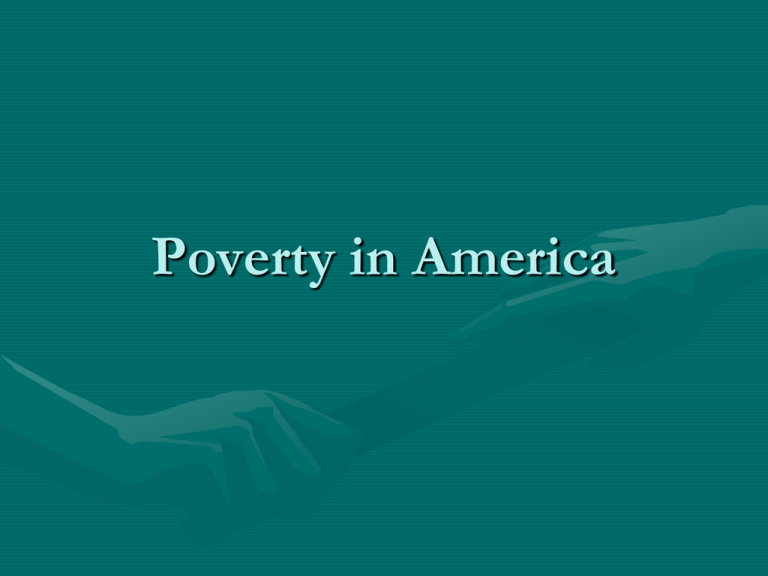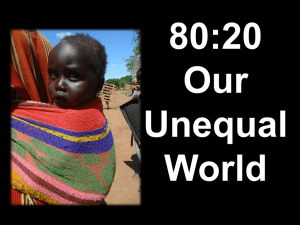
Poverty in America
Poverty
• Poverty is the condition of people who lack
adequate income and wealth.
• Absolute vs. Relative Poverty
• Absolute poverty is the absence of enough
money to secure life’s necessities – enough food
and a safe place to live.
• Relative poverty comparing the economic
conditions of those at the bottom of society and
the rest of society. According to this measure,
the definition of poverty can vary. For example
it would not be the same in India as the U.S.
More than Numbers
• Health: stress, frustration = high blood pressure, ulcers,
hostility, and crime.
– Poor are 3x as likely to die as children
– Black & Latino children are 2x as likely to die before the age
of one.
– Long term health of adults
– Homicide is the #1 cause of death among black males 15-24
• Education: less informed, less likely to vote, 1:4
dropouts = poor
• Opportunities
Who is Poor?
• Women
– 70% of Americans in poverty are women
– 55% of these women are Caucasian / 33% are African
American
• Workers
– 50% of poor people work FULL time (consider elderly)
– 1 in 5 jobs earn 25% the poverty line
• Children in Poverty
–
–
–
–
20% of America’s children
46% of African American children
40% of Latino children
17% of Caucasian children
• Minorities:
http://www.youtube.com/watch?v=y3IW3PhBgjs
• The Elderly
– 14% of people over 65 are in poverty (28% of A.A. /
21% of Latinos)
• The South
Poverty is unevenly distributed in the
U.S.
• Where people live, their race –ethnicity, their sex, their
age, and their marital status all effect their chances of
being poor.
• The states with the highest level of poverty tend to be in
the South and Southwest
• The poverty rate in rural areas of the U.S. is higher than
the national average.
• Compared to urban Americans, the rural poor are less
skilled and less educated. Jobs pay less than similar jobs
in urban areas.
• “Feminization of Poverty”: divorce, births to single
women, and the lower wages paid to women.
Figure 10.6 Poverty in the United States by Age and Race-Ethnicity
Source: Statistical Abstract 2002: Tables 668, 671, 673.
Note: The poverty line on which this figure is based is $18, 194 for a family of four.
Who is Not Poor?
• Among major industrialized nations, the U.S. is the
leader in the gap between the wealthiest 20% and the
poorest 20%.
• The top 5% owns 50% of nations wealth
• 1989
10% = 61% of nation’s wealth
• 1994
10% = 67% of nation’s wealth
• 1999
10% = 72% of nation’s wealth
• Black families make 45% of White Families’ income on
average.
Figure 10.2
Inequality of U.S. Income
Bill Gates is the wealthiest person
in the world.
His fortune runs between $ 50
billion and $100 billion, depending
on the value of stock.
Home in Seattle appraised at $110
million
Gates has given more to poor and
minorities than any individual in
history
http://www.census.gov/dataviz/vis
ualizations/019/
http://thesocietypages.org/socima
ges/page/2/
Why are people poor?
• Human Capital Theory- Lack of education, job training,
job skills or language proficiency.
• Racism, Discrimination and Segregation
• Family Type – absence of 2 parent families
• Culture- assumes there are cultures that value
education, self improvement and motivation more than
others.
• Lack of Employment Opportunities and Low Wages
• Lack of Political Power
Figure 10.8 Who Ends Up Poor? Poverty by Education and Race-Ethnicity
Source: Statistical Abstract 2002: Table 675.
Where Does the Public Stand on the
Matter?
• The majority feel that something needs to be
done
• The majority lacks faith in government to do it
• People tend to support work programs (as
opposed to direct aid)
• The majority of Americans support raising the
minimum wage.
• The majority support a tax hike on the wealthy
• javascript:window.location.reload(true)
Figure 10.7 Patterns of Poverty
Source: Statistical Abstract 2002: Table 673.
Note: Poverty varies tremendously from one state to another. In the extreme, poverty is almost three times as
common in New Mexico (19.3%) than it is in Maryland (7.3%).
WT Journal # 4
• After reading Why Poverty Persists in Appalachia,
discuss Cynthia Duncan’s belief on why poverty
persists. What actions can be done to help the
poor in the Appalachian Region? Explain and
provide examples.









